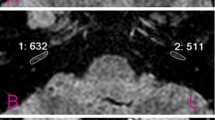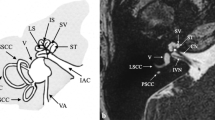Abstract
The sensitivity of different MRI sequences in the detection of inner ear malformations in patients presenting with sensorineural hearing loss (SNHL) and/or vertigo was evaluated. We studied 650 patients presenting with SNHL and/or vertigo, clinically not suspected of having inner ear malformations. The sensitivity of T1-weighted, Gd-enhanced T1-weighted and (when available) T2-weighted spin-echo images, and three-dimensional Fourier transformation-constructive interference in steady state (3DFT-CISS) gradient-echo images, to unexpected malformations was assessed. Inner ear malformations were found in 15 (2.3%) of these patients. Enlargement of the endolymphatic duct and sac was the most frequent malformation, found in 11 patients. The 3DFT-CISS images showed all lesions; the other sequences were less sensitive and the pathology was missed, partially or only retrospectively seen in 11 of the 15 patients. Therefore, in addition to the routine unenhanced and Gd-enhanced T1-weighted and T2-weighted images, thin gradient-echo (3DFT-CISS) images are necessary to detect all clinically unexpected inner ear malformations in patients presenting with vertigo and/or SNHL.
Similar content being viewed by others
References
Casselman JW, Kuhweide R, Deimling M, Ampe W, Dehaene I, Meeus L (1993) Constructive interference in steady state-3DFT MR imaging of the inner ear and cerebellopontine angle. AJNR 14: 47–57
Casselman JW, Majoor MHJM, Albers FW (1994) MR of the inner ear in patients with Cogan syndrome. AJNR 15: 131–138
Valvassori GE, Clemis JD (1978) The large vestibular aqueduct syndrome. Laryngoscope 88: 723–728
Mafee MF, Charletta D, Kumar A, Belmont H (1992) Large vestibular aqueduct and congenital sensorineural hearing loss. AJNR 13: 805–819
Veillon F, Phillipe H, Bourjat P, Binter H (1991) Malformations de l'os temporal. In: Veillon F (ed) Imagerie de l'oreille. Médecine-Sciences Flammarion, Paris, pp 203–242
Casselman JW, Kuhweide R, Dehaene I, Ampe W, Devlies F (1994) Magnetic resonance examination of the inner ear and cerebellopontine angle in patients with vertigo and/or abnormal findings at vestibular testing. Acta Otolaryngol (Stockh) [Suppl] 513: 15–27
Casselman JW, Kuhweide R, Ampe W, Meeus L, Steyaert L (1993) Pathology of the membranous labyrinth: comparison of T1- and T2-weighted and gadolinium-enhanced spin-echo and 3DFT-CISS imaging. AJNR 14: 59–69
Jackler RK, Luxford WM, House WF (1987) Congenital malformations of the inner ear: a classification based on embryogenesis. Laryngoscope 97: 2–14
Emmett JR (1985) The large vestibular aqueduct syndrome. Am J Otol 6: 387–415
Jackler RK, De la Cruz A (1989) The large vestibular aqueduct syndrome. Laryngoscope 99: 1238–1243
Levenson MJ, Parisier SC, Jacobs M, Edelstein DR (1989) The large vestibular aqueduct syndrome in children. Arch Otolaryngol Head Neck Surg 115: 54–58
Tien RD, Felsberg GJ, Macfall J (1992) Fast spin-echo high-resolution MR imaging of the inner ear. AJR 159: 395–398
Hirsch BE, Weissman JL, Curtin HD, Kamerer DB (1992) Magnetic resonance imaging of the large vestibular aqueduct. Arch Otolaryngol Head Neck Surg 118: 1124–1127
Majoor MHJM, Albers FWJ, Casselman JW (1993) Clinical relevance of magnetic resonance imaging and computed tomography in Cogan's syndrome. Acta Otolaryngol (Stockh) 113: 625–631
Sando I, Takahara T, Ogawa A (1984) Congenital anomalies of the inner ear. Ann Otol Rhinol Laryngol 93 [Suppl 112]: 110–117
Petasnick JP (1973) Congenital malformations of the ear. Otolaryngol Clin North Am 6: 413–428
Lagundoye SB, Martinson FD, Fajemisin AA (1975) The syndrome of enlarged vestibule and dysplasia of the lateral semicircular canal in congenital deafness. Radiology 115: 377–378
Mafee MF, Selis JE, Yannias DA, Valvassori GE, Pruzansky S, Applebaum EL, Capek V (1984) Congenital sensorineural hearing loss. Radiology 150: 427–434
Phelps PD (1974) Congenital lesions of the inner ear, demonstrated by tomography. Arch Otolaryngol 100: 11–18
Parnes LS, Chernoff WG (1990) Bilateral semicircular canal aplasia with near-normal cochlear development. Ann Rhinol Laryngol 99: 957–959
Harnsberger HR, Dart DJ, Parkin JL, Smoker WRK, Osborn AG (1987) Cochlear implant candidates: assessment with CT and MR imaging. Radiology 164: 53–57
Klein HM, Bohndorf K, Hermes H, et al (1992) Computed tomography and magnetic resonance imaging in the preoperative work-up for cochlear implantation. Eur J Radiol 15: 89–92
Author information
Authors and Affiliations
Rights and permissions
About this article
Cite this article
Casselman, J.W., Kuhweide, R., Ampe, W. et al. Inner ear malformations in patients with sensorineural hearing loss: detection with gradient-echo (3DFT-CISS) MRI. Neuroradiology 38, 278–286 (1996). https://doi.org/10.1007/BF00596549
Received:
Accepted:
Issue Date:
DOI: https://doi.org/10.1007/BF00596549




